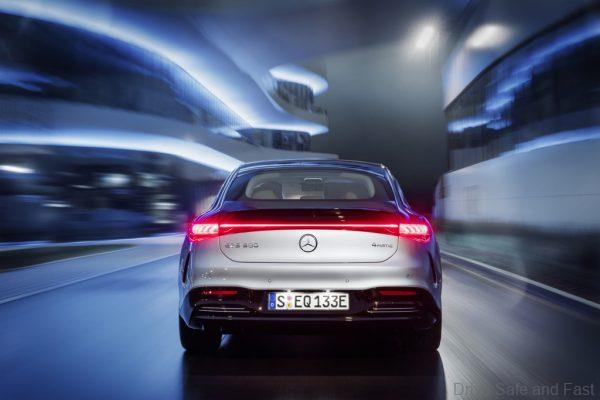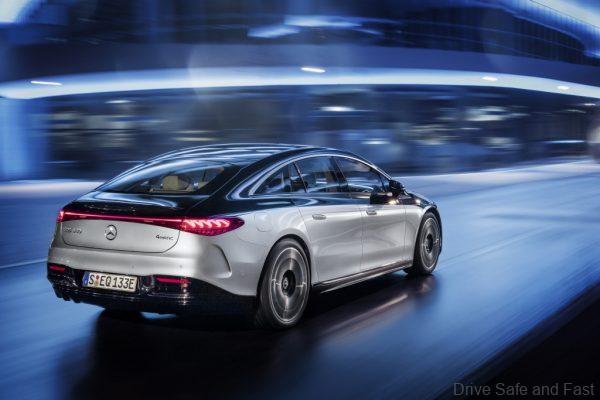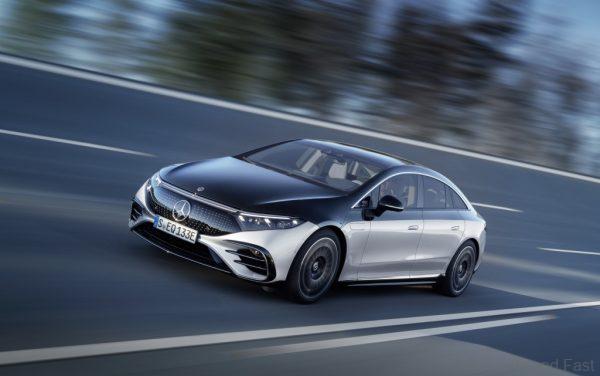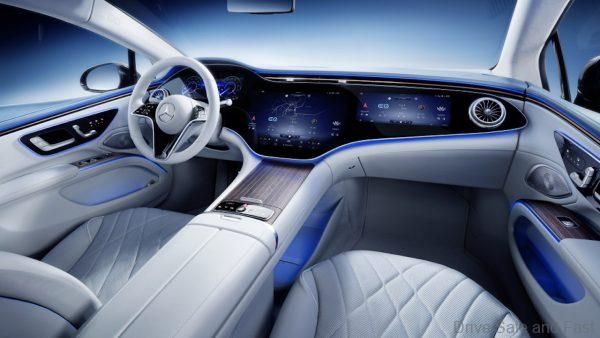Mercedes-Benz EQS Debuts With 2 Variants At Launch
The Mercedes-Benz EQS has the longest electric range, lowest drag coefficient and many more impressive metrics!
Tesla may have had a 9-year head start in the electric sedan market, but Mercedes-Benz finally has an answer and an impressive one at that! It’s the all-new EQS.

This EQS is the third of at least 8 all-electric models that will form part of the Mercedes-EQ all-electric family.

Despite being released so close to the latest S-Class, the EQS is built on a completely different platform. As such, it has many different styling cues, such as a cab-forward design and fastback styling.
There’s a lot to talk about, so let’s get started with the EQS variants.
Two drivetrain variants will be offered at launch:
- EQS 450+
- Rear-wheel drive
- single motor
- 245kW
- 568Nm of torque
- 0-100km/h in 6.2s
- max energy recovery: 186kW
- EQS 580 4MATIC
- all-wheel drive
- dual motor
- 385kW
- 855Nm of torque
- 0-100km/h in 4.3s
- max energy recovery: 290kW
An unnamed performance model with 560kW of output is also in the works.
The EQS 450+ has the lowest drag coefficient of any production vehicle at just 0.2cd, making it the most aerodynamic car in the world. Mercedes-Benz also claims that it is one of the quietest vehicles in the world.

The latest generation of battery technologies is found in the EQS, enabling 107.8kWh of usable energy content, 26% more than what’s found in the EQC. These batteries are updated over the air with the latest management software.

The maximum range is expected to be 770km on the WLTP cycle with 200kW DC fast charging providing 300km of range in 15 minutes or a full charge in 31 minutes. Over AC, the 107.8kWh battery is fully charged in 10 hours (11kW) or 5 hours (22kW). On the move, the EQS is able to recuperate a large amount of energy, and the driver can select the level of energy recovery via the paddle shifters.
Rear-axle steering is standard on the Mercedes-Benz EQS and this goes up to 4.5 degrees by default. Inside, MBUX has been updated to work with the all-new Hyperscreen. The EQS will also have hidden features that can be unlocked through little in-car games. You may get access to things like an additional 10 degrees of rear-wheel steering. You can also trial, subscribe to or purchase individual functions.

A new Energizing Air Control Plus climate system is found in the EQS, with an optional HEPA filter that is certified to kill viruses and bacteria. The system advanced enough to detect air quality suggests closing the windows. Another option is the automatic comfort doors which extend door handles as the driver approaches and then automatically opens the driver door as he or she approaches. MBUX can be used to open rear doors as well.

Here’s the press release with an explanation of the Mercedes-Benz EQS’ driver assist and safety systems.
PRESS RELEASE
Thanks to powerful sensors that monitor the vehicle’s surroundings, the parking systems can help the driver with manoeuvring in many areas. The driver can park and unpark the car via smartphone using Remote Parking Assist. With the pre-installation for the INTELLIGENT PARK PILOT, the EQS is prepared for Automated Valet Parking (AVP, SAE level 4). If equipped with the required optional extra and the corresponding Connect service (depending on the country), the vehicle has the technology on board to park and unpark fully automatically and without the driver in car parks equipped with AVP infrastructure, provided that national laws allow such operation.
The revolutionary DIGITAL LIGHT headlamp technology (standard from Advanced Plus equipment level) enables guide markings or warning symbols to be projected onto the road. New are the two assistance functions[7] that display the start of the cooperative lane change and provide a warning/direction instruction if Lane Keeping Assist or Blind Spot Assist detect a hazard. DIGITAL LIGHT has a light module with three extremely powerful LEDs in each headlamp, whose light is refracted and directed by 1.3 million micro-mirrors. The resolution is therefore more than 2.6 million pixels per vehicle.
With the optional DRIVE PILOT, the EQS will be able to drive in conditionally automated mode at up to 60 km/h where traffic density is high or in tailbacks on suitable motorway sections, initially in Germany. By relieving the pressure on the driver, the system enables him or her to undertake secondary activities[8] such as browsing on the internet or dealing with emails in the In-Car Office, and so gain extra time.
The MBUX Hyperscreen is the absolute highlight in the interior. This large, curved screen unit sweeps almost from A-pillar to A-pillar. Three screens sit under a cover glass and appear to merge into one. The 12.3-inch OLED display for the front passenger gives him or her their own display and control area. The entertainment functions are only available there while the car is being driven in accordance with the country-specific legal regulations. Mercedes-EQ relies on an intelligent, camera-based locking logic: if the camera detects that the driver is looking at the front passenger display, it is automatically dimmed.
With adaptive software, MBUX adapts completely to its user and makes personalised suggestions for numerous infotainment, comfort and vehicle functions. With the zero layer, the most important applications are always offered on the top level within the field of vision, according to situation and context.
The latest generation of driver assistance systems includes numerous driver support functions. New, for example, is the additional microsleep warning from ATTENTION ASSIST. It analyses the driver’s eyelid movements through a camera on the driver’s display (only in conjunction with MBUX Hyperscreen). The assistance display within the driver’s display shows the operation of the driving assistance systems in a comprehensible full-screen view.
The principles of Integral Safety, in particular accident safety, apply regardless of the platform. Like all other Mercedes, the EQS therefore features a rigid passenger cell, special deformation zones and state-of-the-art restraint systems. PRE-SAFE® is standard. The fact that the EQS is based on an all-electric architecture also opened up new design possibilities for its safety concept.
It meant, for example, that a favourable location could be chosen for the installation of the battery, in a crash-protected area in the underbody. And because there is no large engine block on board, the behaviour in a frontal crash could be modelled even better. In addition to the standard crash tests, the car’s performance in various additional load situations was verified and extensive component tests carried out at the Vehicle Safety Technology Centre (TFS).








